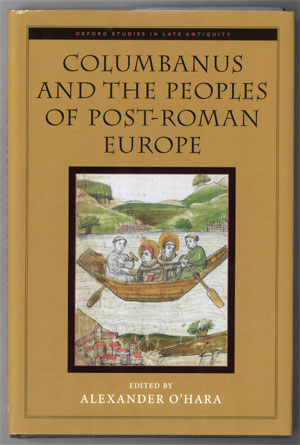COLUMBANUS AND THE PEOPLES OF POST-ROMAN EUROPE
Published in Book Reviews, Book Reviews, Issue 3 (May/June 2019), Reviews, Volume 27ALEXANDER O’HARA (ed.)
Oxford University Press
£61
ISBN 9780190857967
Reviewed by: Carlo Cedro
Carlo Cedro is currently preparing a doctoral dissertation on Columbanus in the Department of History, Trinity College Dublin.

When the Irish abbot Columbanus travelled through early seventh-century Europe, he moved within a fluid matrix of ethnic, political and cultural realities adapting to the changes brought about by the collapse of the Western Roman Empire. Having left Ireland on an ascetic journey as recounted in the Vita Columbani, Columbanus founded monastic communities in Brittany and Burgundy in the last decade of the sixth century. After being exiled for his falling out with the Merovingian monarchy, he travelled north across the Rhine into what is now northern Switzerland, before finally crossing the Alps and passing away in his last foundation, Bobbio, in 613. In addition to the lasting cultural legacy of Bobbio and Luxeuil, Columbanus is known as the first of the Irish authors on the Continent, with several Latin works being attributed to him.
This collection of essays deals with Columbanus’s own activities and legacy, but it is also concerned with framing them within the wider European context of interactions and exchanges among the various post-Roman gentes. In the introductory chapter, editor Alexander O’Hara refers to the monk as a catalyst for change in religious practices and the shifting of cultural horizons. The encounter and exchanges between islands and continent, he argues, as well as the channels between various regions under Merovingian influence that were opened by the Columbanian movement, helped to lay the foundation for the integration of the western churches into a more cohesive whole, such as they would later become during Carolingian times.
The five-part structure of the book loosely follows a geographical arrangement that reflects the stages of Columbanus’s journey through Europe, helpfully illustrated by four maps at the beginning of the volume. Three contributions address the move from his native Ireland: Dáibhí Ó Cróinín speculates on the possibility that Columbanus may have been a member of a royal Leinster dynasty, suggesting that his exile might have been politically motivated, like that of his elder contemporary, Columba of Iona, while Alex Woolf’s consideration of Columbanus’s formative years in Ulster gives insight into the earliest phase of Irish Christianity, proposing new identification of names found in the sources and highlighting connections between other significant figures of the period, such as Gildas and Uinnianus. Elva Johnston addresses the role of women in Columbanus’s career, both in his homeland and abroad, by analysing the figures of his mother, of the unnamed anchoress who encouraged him to set out on his ascetic journey and of the queens Brunhild and Theudelinda, both in the way in which they are framed by the sources and in the light of what is known of contemporary women’s conditions and agency in very different contexts: Early Christian Ireland and post-Roman royalty. In one of the highlights of the volume, Clare Stancliffe reconstructs how the idea of shunning as a religious practice, as it was shaped by the insular churches, might provide a key to interpreting the way in which Columbanus and his community dealt with situations of conflict, with both secular and ecclesiastical authorities.
The second and third sections of the volume dedicate much space to the Columbanian monks’ interactions with people at the periphery of seventh-century Europe: insular influences in Brittany are discussed by Ian Wood, while Herwig Wolfram investigates the context of a Hiberno-Frankish mission to the Bavarians and the Slavs. Two contributions by Yaniv Fox and Philipp Dörler focus on the activity of Gallus, the rebellious disciple of Columbanus, whose posthumous importance to the monastic movement is attested by the Carolingian monastery that bears his name. In the one chapter dedicated to Bobbio and the last years of Columbanus, Stefano Gasparri reconstructs the history of the relationship between the monastery and the Lombard monarchy while providing a critique of Italian historiography on the subject. Finally, the first and last contributions belong to the field of textual criticism. The former, by Damian Bracken, argues that the letters of Columbanus are steeped in the Early Christian tradition of reconciliatory language, employing many of the stylistic features associated with the idea of concord, thus unusually framing the Irish abbot as a mediator rather than an instigator in the controversy in which he was involved. By contrast, Albrecht Diem deals with the expression of dissent and insubordination within the monastic group, providing a translation of one particular monastic Rule, derived from that of Columbanus, which might have been produced by one of the many splinter groups that were formed during the early transitional phase of the Columbanian communities after the death of the founder.
To conclude, the book is rich in content, and innovative and comprehensive in its approach. Each contribution is accompanied by an up-to-date bibliography and manages to apply new conceptual tools to older problems of Columbanian scholarship. The reader will find much that is of general interest for the study of the period and will gain considerable insight into the dynamics of inter-group relationships during an important phase of European history.
















